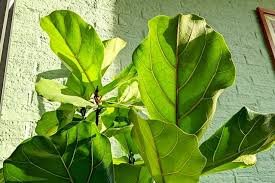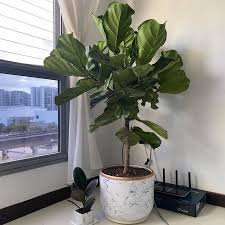
Ficus lyrata, popularly known as the fiddle-leaf fig, is a favorite among houseplant enthusiasts for its striking, violin-shaped leaves and elegant presence. However, caring for this tropical beauty can be a challenge for beginners. If you’ve just brought home a ficus lyrata or are planning to, this guide will help you keep it healthy and thriving.
1. Light: Bright and Indirect
Ficus lyrata thrives in bright, indirect light. Place it near an east- or south-facing window where it can receive plenty of natural light without being exposed to harsh, direct sunlight, which can scorch its leaves. If natural light is limited, consider using a grow light to supplement its needs.
2. Watering: Strike a Balance
Getting the watering schedule right is crucial for a healthy fiddle-leaf fig. Water the plant when the top 1-2 inches of soil feel dry. Overwatering can lead to root rot, while underwatering may cause the leaves to brown and drop. Ensure the pot has drainage holes, and avoid letting the plant sit in standing water.
3. Humidity and Temperature: Keep It Tropical
As a native of West African rainforests, ficus lyrata loves humidity. If your indoor air is dry, use a humidifier or mist the leaves occasionally. The ideal temperature range for this plant is 60-75°F (16-24°C). Avoid placing it near drafts, heaters, or air conditioning vents, as sudden temperature changes can stress the plant.
4. Soil and Fertilization: Nourish the Roots
Use a well-draining potting mix, ideally one designed for houseplants. During the growing season (spring and summer), feed your fiddle-leaf fig with a balanced, water-soluble fertilizer once a month. Reduce feeding during the dormant winter months.
5. Pruning and Cleaning: Maintain Its Beauty
Regularly clean the leaves with a damp cloth to remove dust and keep them shiny. Prune any damaged or yellowing leaves to encourage new growth. If you want your ficus lyrata to branch out, you can pinch the top leaves to promote lateral growth.
6. Troubleshooting Common Issues
- Brown Spots or Edges: Often caused by underwatering or low humidity.
- Yellowing Leaves: Could indicate overwatering or poor drainage.
- Leaf Drop: Typically a sign of sudden environmental changes or stress.
Conclusion
Caring for a ficus lyrata may seem daunting at first, but with proper light, watering, and attention to its tropical needs, it will reward you with lush, vibrant growth. This iconic houseplant not only enhances your home’s aesthetic but also purifies the air, making it a valuable addition to any space. Follow these tips, and your fiddle-leaf fig will thrive for years to come!



